#art forgery
Text
you got your known Minoans and your unknown Minoans (part four)
(reposted, with edits, from Twitter)
(part one, part two, part three on Tumblr)

Where were we? Oh yeah, bagging on Arthur Evans, right?
(You’re going to want to read Parts 1-3, linked above, if you haven’t already or this won’t make much sense.)
Did I mention in this that even though women appear frequently in other types of Minoan art, no composite ivory statuettes that are both definitely female and definitely genuine have been found? Interesting side note. Like the one thing we know about the Minoans is Snake Goddesses, right? Well, that and Bull Jumpers.
It’s hard to overstate the hold Minoan art still has on the Western imagination.

Image: A copy of a translation of the Odyssey, using the Blue Ladies fresco as cover art. Ironic, given that the culture that produced the Odyssey is probably the one that destroyed the Minoans.
Anyway, the problem is there are a ton of these composite ivory Minoan goddess statues floating around, none of them have reliable provenience, and they're what were used to authenticate each other. See the problem?
Some of them are proven forgeries. So a lot of what is "Minoan-looking" in our minds is forgeries, possible forgeries, and "restorations" done by turn-of-the-century artists.
And as we learn more about them, we find out that a lot of the assumptions were very much dictated by Victorian expectations. Those "corsets" or "jackets" Minoan women are depicted as wearing? Actually shifts with skirts tied around them.
There are a lot of problems with the Boston Goddess. She's too skinny, for one. And if, as some have suggested, her hips and butt are so flat because the ivory is significantly worn away, how are the details of her flounces still visible there? The Boston Goddess (or rather, the fragments of her not used in the restoration), the Seattle Boy-God, and the Ashmolean Boy-God have all been carbon tested. The results were intriguing-- 250ish years old for the Ashmolean figure, and 400-500 for the other two. That's deeply weird. Obviously, the ivory is far too new for them to be genuinely Minoan, but it's awfully old for a Victorian forgery.
But in any case, enough about the artifacts themselves. I want to talk about the conclusions Evans drew from them, which have been repeated as fact in a lot of books and textbooks and journals and magazines since.
The Great Goddess and Her Salesman-Priest
Classical goddesses go in and out of fashion. For most of the Renaissance, all the way to the 1800s, writers mentioned Venus and Diana most often, followed by Minerva/Athena and Juno/Hera. Diana was associated primarily with chastity.
In the Romantic era, Venus was still the most popular goddess (although she was now associated with natural surroundings), and Diana was associated with the moon and animals more than chastity. Proserpina/Persephone and Ceres/Demeter also gained prominence (earth/seasons).
So, the Romantics were very much enamored with the idea of Mother Earth/nature as female (go conquest that land in "virgin" America, yo). The concept wasn't new--lots of cultures personify the earth as female--but this was very much a 19th-century European imagining.
Basically a lot of Victorian dudes liked the idea of their porn involving pretty landscapes.
So, along comes a German dude named Friedrich Wilhelm Eduard Gerhard, because everything you say is credible if you're a white dude with four names, who's like "hey maybe all those Greek goddesses were actually ONE goddess, and she was Mother Earth, that tempestuous temptress."
And like as far as I can tell, that was it. That's the Tweet. He had An Idea about how ancient religion might have worked, and everyone nodded sagely and suddenly it was a theory. The Greeks actually believed in one goddess, with a bunch of different faces.
And then, some of those other dudes nodding along sagely to this theory that didn't arise organically from studying the actual writings and artifacts of the time, but from Mother Earth as a concept being trendy in the 1850s, were like, hey, so we know that the Anatolians and Mesopotamians influenced ancient Greek thought, so if the Greeks worshipped a single goddess, the Anatolians and Mesopotamians must have too!
And then they were like, hey, it was probably also true across Europe! Because there's this <checks notes> Swiss judge named JJ who thinks all of human society was once matriarchal and only later evolved into patriarchy so it seems logical that everyone worshipped a goddess.
For those following along at home, no, this is not how logic works, but these dudes were probably drinking a LOT of absinthe.
Goddess Worship Isn’t Love For Women
Now, one might point out, for example, that the ancient Athenians literally had a goddess as their patron deity and still managed to, arguably, utterly despise women more than anyone else in the world at that time, so clearly goddess worship doesn’t automatically equate to matriarchy, but anyway.
But Jessica! (I can hear you saying, o theoretical reader) You're such a shrieking feminist harpy that you put "howling maenad" in your Twitter bio. Why are you objecting to the idea of widespread ancient matriarchy and female-centered monotheism (or duotheism, since there was also a god)?
Well, here's the thing. It's certainly a cool idea. And it even makes a sort of pop-psychology sense. Back in the Stone Age, maybe men hadn't yet figured out that they were involved in the reproductive process and so deferred to women as life-givers.
But that sort of thinking can lead us to dismiss or ignore real history. Women have always led, women have always fought, women have always ruled, and that shouldn't be manwashed away. But that doesn't mean it was normative. And it matters--both for truthfulness and to fully appreciate what the women who managed to lead actually accomplished--if it wasn't normative. It can also make us miss that matriarchy--*real* matriarchy--isn't necessarily the mirror of patriarchy.
When I was in college, in one of my anthropology classes, we had a textbook that said that there was no such thing as matriarchy, except as a theoretical concept. There was matrilineality, and matrilocality, but not matriarchy.
Was it true? Well, here's the thing: if you define matriarchy as we define patriarchy, but just replace "men" with "women" in the description, arguably it is true that matriarchy doesn't exist. To the best of my knowledge, no one’s found evidence of societies where women treat men like men treat women in patriarchal societies.
But there are, and have been, societies where women own the property, societies in which elder women are the primary leaders/authorities, etc. But they don't attempt to exert control over men in the same way men do over women in a lot of patriarchal societies. So it becomes largely a semantic argument. If it isn't an exact analogue to patriarchy, is it matriarchy? Honestly, I've ceased caring all that much about the terminology, and am more interested in how leadership and authority function in those societies.
But anyway, the Romantics weren't feminists. Just because you like the idea of the feminine as emotional and intuitive and nature-y doesn't mean you give a shit about actual women. And as the Victorian Angel In The House would show us, every pedestal has a cage atop it.
The Romantics might profess to revere Mother Nature, but at the end of the day, they revered her as an object: there to be conquered if they wanted to feel manly, there to challenge them if they wanted to feel manly in a different way, there to soothe and inspire them as Muse, and even there to kill them if they were into the idea of la petite mort being la grand mort.

Image: Just a dude really into being penetrated... with arrows.
And Bachofen, our pal JJ the Swiss judge who also had Theories about anthropology, considered humanity's "Demetrian" matriarchal stage just a necessary transitional period on its way to "Apolline" patriarchy, the pinnacle of human evolution.
They dug up a lot of Venus of Willendorf-like figurines (lots of male-looking and animal ones too, but those didn't fit the theory and got ignored) and decided that they represented a single prehistoric Mother Goddess, source of fertility.
I mean here's the thing: when archaeologists find something and they don't know what it is or what it's used for, a popular default category is "ritual object." If you then start forming theories about how religion worked based on your collection of ritual objects, well, you can imagine how that goes.
So this is the milieu into which Arthur Evans was to release his Minoan discoveries. He writes a lot about the "Great Minoan Goddess" and "the matriarchal stage of society, to which the Minoan religious system owes its origin."
I Regret to Introduce You To Jane Harrison...
So along comes Jane Harrison, who is all into JJ's theory about ancient matriarchy as the fullest collection of "ancient facts"--poof! the theory has become fact--and was also very into the idea that all goddesses are actually a single Great Goddess.
If you don't know anything about Jane Harrison, you might be thinking, "oh, good! at last, a woman weighing in on ancient matriarchy. Perhaps we'll get a take that isn't so... patriarchal.”
Allow me to introduce you to Jane Harrison:
"Matriarchy gave women a false sense of magical prestige. With patriarchy came inevitably the facing of a real fact, the fact of the greater natural weakness of women. Man is the stronger, and when he outgrew his belief in the magical potency of woman, proceeded by a pardonable practical logic to despise and enslave her."
...And All These Other Assholes
Another member of these circles was Sir James George Frazer (only three names there, but also has a "Sir" so probably as credible as the four-name dude). Remember him? The Golden Bough? Yeah.
He looooved the idea of a single Great Mother Goddess and attempted to collect and catalogue world myth and folktales and wanted to trace her and her ever-dying younger consort as a universal or near-universal archetype in human consciousness.
You want Joseph Campbells? This is how you get Joseph Campbells. But Joseph Campbell is a rant for another time.
Carl Jung and Marija Gimbutas, incidentally, thought along similar lines and considered it a universal archetype present in all human psyches, and all cultures.
No writing or art about it from a particular culture? No evidence that it’s actually a thing? *hand wave* Whatever.
Part of what was animating all this thought was confidence that human culture was evolutionary--that there was a relatively smooth line of human progress from a primitive past to an enlightened present to a utopian future.
I mean, the Bronze Age collapse might beg to differ. But what do I know? I'm not a white dude with four names and or a "Sir".
Incidentally, this Victorian confidence that human civilization is smoothly evolutionary appears to be literally killing us right now but let's pretend this is all fun archaeology stuff to mute the silent internal screaming.
Oh Wait, I Forgot To Tell You About The Cat
Anyway. All of these assumptions very much influenced how Evans interpreted what he found, and presented it to the public. Female snake handlers, for example, are actually pretty rare in Minoan art (maybe even all forged), but you wouldn't know that from textbooks about it.
It affected how he arranged the things he found when attempting to recreate altar assemblages.
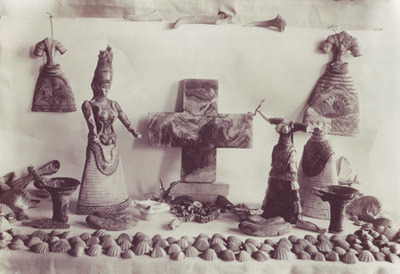
That cross in the assemblage above? They found that and decided that it MUST have religious significance and be the centerpiece of an altar... ...because Christianity, basically.
You know that famous Snake Goddess figurine?
The faience one that isn't a suspected complete fake? You've probably seen her. You can buy earrings of her on Etsy.

That cat on her head?
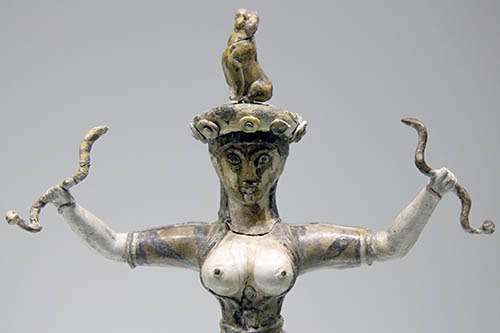
Yeah, it's a random cat that they found elsewhere and decided to stick on her head.
...because the Anatolian and Mesopotamian goddesses they liked to use as proof of a universal singular Great Mother Goddess were often pictured with lions.
So, you know: cat-hat.
About Those Snakes...
So anyway, snake-handling female figures were actually a relatively rare find in Minoan art, but Evans decided she was their central deity, a manifestation of the Great Mother Goddess whose primary attribute was fertility.
But here's the thing: we don't have any writings we can read from the Minoans. All we have is visuals (mostly "restored" by Victorian artists), and we don't *know* what any of their symbolism meant to them. And even a lot of the visuals aren't helpful.
We know that depicting women with bared breasts (not topless, with a garment framing them, which seems very deliberate) was a thing. We don't know what that means. We don't know if this was reflective of *actual clothes that women wore* or whether it's symbolic (like Artemis wearing a crescent moon in her hair). We don't know what breasts meant, in their visual language.
Minoan art doesn't depict children very often, and doesn't depict nursing mothers at all (unlike Egyptian or mainland Greek art). So do breasts represent fertility in their visual vocabulary? No idea.
Are bared breasts considered erotic? Again, no idea. That assumption was strongly tied to the snakes, which are tied to Christian associations of snakes with sexuality--specifically sexual sin. If the bared-breasts women were actually even originally depicted with snakes.
Ultimately, we don't even know if the statue of a snake-handling woman represents a goddess, a priestess, or a woman representing or symbolizing something else entirely. Frankly, we don't even know what her face actually looked like.
Despite various authors rhapsodizing about the "sternness of her expression" and whatever else, the entire face of this famous statue, and her snakes, were fashioned by Halvor Bagge, a restorer/artist. She might have been holding sheaves of grain, for instance. She might have been smiling gently. She might have looked afraid. We don't know.
We know very little.
Who Better To Say What We Want than Those Who Can’t Speak?
Because the Minoans didn't leave behind any writing we can read, and most of the art we have from them had to be heavily restored by Victorian artists, they provided a perfect blank slate for Victorian men desperate to prove European superiority to project onto.
Now. Archaeologists *aren't* just people who dig up old stuff. Interpreting the past is something we have to do if we want to try to understand it. And there's nothing wrong with putting forth theories. But it becomes a problem when it's not made clear that these are theories, when theories are built upon theories upon theories upon theories, with no clear substantiation for any of it. Theory slides into "fact" very easily.
And it can very easily become circular. Evans used theories about other cultures worshipping a single Great Goddess to guide what he looked for on Crete and how to present what he found, which has looped around to Crete being the center of Great Goddess worship and being used to substantiate the idea of singular Great Goddess worship in some of the same cultures whose practices were used to suggest that Crete might be like they were. Much like ivory statuettes with no provenience were used to substantiate others.
And all of that is then used as evidence of How Human Culture Works. So suddenly The Center Of Ancient Mediterranean Worship is safely in Europe.
When, as far as what can actually be verified, what doesn't come out of the airy, tempestuous realms of Romantic theory, is almost nothing.
We still don't know the Minoans.
Fin.
#archaeology#arthur evans#crete#white supremacist archaeology#snake goddess#art forgery#minoan art#matriarchy#goddess worship#the great goddess#romanticism#minoan#minoans
97 notes
·
View notes
Text
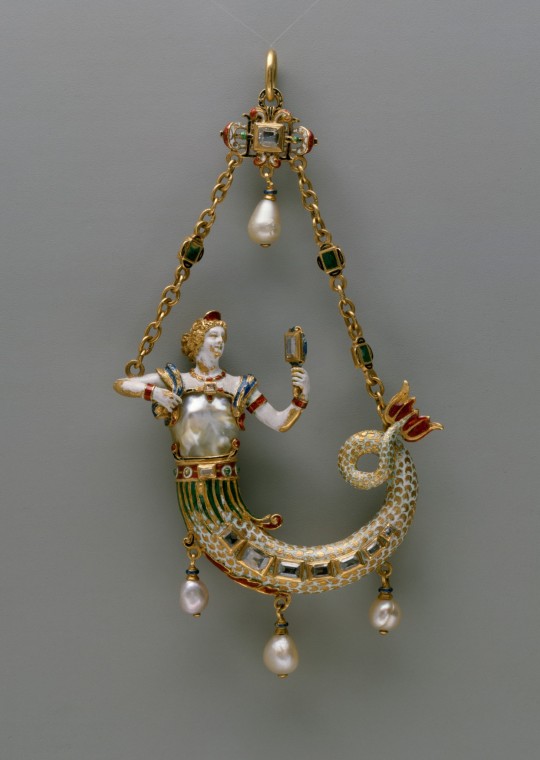






https://en.m.wikipedia.org/wiki/Reinhold_Vasters
#reinhold vasters#art forgery#19th century#16th century#17th century#northern mannerism#goldsmith#benvenuto cellini#wenzel jamnitzer#mannerism#my post
27 notes
·
View notes
Link
The museum sued its ousted director for financial and reputation damages over the show raided by FBI agents last year.
The Orlando Museum of Art is pursuing a potential settlement in its case against ousted museum director Aaron De Groft and the owners of the paintings included in last year’s scandal-ridden “Heroes & Monsters: Jean-Michel Basquiat” show, per new court documents and a report in the Orlando Sentinel Tuesday.
According to the filing with the Orange County circuit court, in August the museum sued De Groft and the group who collectively owned a series of paintings contentiously attributed to the late artist Jean-Michel Basquiat. The museum has alleged that the two parties leveraged the show to lend legitimacy to the works so they could be sold afterwards, despite well-publicized doubts to their attribution. De Groft has been accused of working out a deal to pocket a cut if the works found buyers. ...
... De Groft and the owners of the supposed Basquiats have denied wrongdoing and maintain that the pieces are real.
In its lawsuit, the museum has claimed significant financial and reputation damage due to its hosting of the 2022 show “Heroes & Monsters”, which was shuttered early in June that year when FBI agents seized its contents—25 paintings attributed to Basquiat—from the premises in view of visitors. De Groft was ousted by the board of trustees only four days after the raid.
De Groft and the paintings’ owners unveiled the paintings to the public in February of 2022, claiming that the works were created around 1982 by Basquiat while he lived and worked in the Los Angeles residence of dealer Larry Gagosian. Per their story, the works were sold without Gagosian’s knowledge to a private collector, who forgot them in a storage unit for decades. An FBI affidavit provided evidence to the contrary, including an interview with the purported original owner of the paintings who swore he had never patronized the famed artist. ...
3 notes
·
View notes
Link
youtube
Over 1,000 paintings seized, 8 people arrested in Norval Morrisseau art fraud, March 3, 2023
More than 1,000 paintings were seized and eight people face a total of 40 charges resulting from a years-long police investigation into the forgery of artwork by Anishinaabe artist Norval Morrisseau.
CBC News
@allthecanadianpolitics
#Anishinaabe#Norval Morrisseau#indigenous peoples#Woodland School#Indian Group of Seven#Bingwi Neyaashi Anishinaabek First Nation#First Nations#Copper Thunderbird#Canadian#art#Canada#LGBTQ#art forgery#Ontario#Thunder Bay#Woodlands style#art history#fraud#news#APTN#CBC
12 notes
·
View notes
Photo

Art forging experts have spent literally years trying to discern which is the real MC Escher but I'm the only one who knows the truth
10 notes
·
View notes
Text
Lol someone offered me these Basqiats before it was officially declared forgery and just hearing the story and seeing the pictures I was like girl...these aren't real. And she was all "then why would a museum put them up" and i was like 100 reasons - money, press, money, attendance, money...and she was like they are real you'll get 5% if you can place them! And i was like...they aren't but you go ahead and find someone!
Spoiler alert: She didn't, they weren't, it was lololol for me in my office alone during quarantine.
14 notes
·
View notes
Text
This is absolutely crazy. Every sentence gets more wild, it sounds almost too wild to be reality, like it could be a tv drama (and knowing Netflix it probably will be eventually)
9 notes
·
View notes
Text

drawing in the style of Giovanni Battista Piranesi, drawn by forger Eric Hebborn.
#eric hebborn#giovanni battista piranesi#piranesi#neoclassicism#art#art history#painting#forgery#art forgery#fake art
2 notes
·
View notes
Text
Painting For Cash Numbers
Who doesn’t love a good art forgery story? It’s an intriguing mixture of high-end culture and old-time deception. Do we root for the forger? The artist? The police and investigators, charged with insuring the integrity of what must be an extremely messy business?
These and other questions came to mind in reading Tony Tetro’s memoir, Con/Artist: The Life and Crimes of the World’s Greatest Art…

View On WordPress
2 notes
·
View notes
Text
Reasons to go to an art forgeries museum instead of the louvre
They probably already have all the paintings you want to see, besides which you probably aren't familiar with them anyways
Like every painting is gonna have a cool true crime backstory
It's not going to be as popular, so there'll be less people, so you'll have more time to look at the paintings
At least one of them is almost guaranteed to be the original by mistake
Imagine walking into a room and seeing 50 not quite right Mona Lisas
It's probably cheaper
You don't need to understand the deeper meaning to the art because the deeper meaning is we needed to forge this painting so we can do crimes
The art industry is already a huge money laundering scheme, so frankly this is just the most honest art museum you can go to
6 notes
·
View notes
Text
you got your known Minoans and your unknown Minoans (part one)
(reposted, with edits, from Twitter)

Image: The famous “Ladies in Blue” Minoan fresco.
I’ve been thinking a lot about the Minoans. Everyone loves the Minoans, right?
(If you love the Minoans, you are not going to love this series of posts.)
Part One: The Case of the Very Victorian Goddess
Let’s start with a description of the pop culture perception of the Minoans: a peaceful ancient Greek culture with sophisticated, surprisingly modernist art, and extremely sophisticated technology like running water, who were lovers of beauty and peace.
So, I read Mysteries of the Snake Goddess: Art, Desire, and the Forging of History by Kenneth Lapatin. The author focuses on the (now, I believe, pretty thoroughly debunked) Boston Goddess, a supposedly Minoan ivory figurine of a snake-handling woman. She was an absolute SENSATION when she was first displayed.

Image: The Boston Goddess
Sir Arthur Evans, the most famous archaeologist of the Minoan civilization, dubbed her the "Minoan ambassadress to the New World." She made a 1967 issue of Mademoiselle's list of "art sensations" alongside Rembrandt, Picasso, and Rodin. The Museum's monthly bulletin for Dec 1914 proclaimed her an icon of a "wonderful prehistoric civilization which, after having lain submerged, like the lost Atlantis, for three thousand years, has been brought to light again..."
A comparison to Atlantis here is telling.
Victorian "race science" and Victorian occultism were inextricably linked, the latter demonstrating a passion for interpreting the myths of non-European cultures to reflect the ideas of the former. (Its descendants live on as Ancient Aliens theories, etc.) As archaeology became more popular and contact with ancient, sophisticated, and enduring civilizations such as those in India and China increased, white Europeans (especially the Brits) and Americans started to get uncomfortable.
So they started coming up with theories that hey, those people in the East who built all that amazing stuff, who were the "cradle of civilization," who invented the alphabet? They must have been taught by an even OLDER white civilization, now lost.

Image: The Palace of Atlantis by Lloyd K. Townsend, late 19th century, everyone is very Nordic-looking.
Hence the passion for stories about Atlantis and other lost continents. It just couldn't be true that those non-Europeans were building bigger, more sophisticated civilizations long before most (northern) European civilizations built recognizable cities at all.
That longing for proof of ancient European cultural superiority was in the air when excavations of Minoan sites began.
We must have The Oldest Masters
Now, back to the Boston Goddess. Lacey Caskey, writing for the museum, noted that the statuette's distinctive posture "seems not to have been an artistic convention, but a feature of the actual appearance of this aristocratic race."
This aristocratic race. Oof.
Lapatin observes, in the book, that "Minoan civilization was all the rage, for it seemed to provide Europeans with not only the roots of the ‘Golden Age of Greece,’ long considered the foundation of Western culture, but also a sophisticated early society in its own right, a rival to the 'Oriental' cultures of ancient Egypt and Mesopotamia--known as the cradle of civilization..."
Victorian occultists, of course, tended to claim that their practices were derived from ancient Egyptian or Chaldean rituals. And again, even as they attempted to partake of the antiquity and sophistication of those cultures, they were also trying to prove that white people, or at least divine beings (rather than non-Europeans), built them. (It's always been a bit ironic to me that the Victorians clung to the idea of the superiority of Greece and Rome as the foundation for their ideas of the superiority of white people, while considering contemporary Greeks and Italians not fully white, but I digress.)
And lest you think that I'm hammering too hard on this point, some of the most prominent descriptions of Evans' finds praised the Minoan frescoes as "the Oldest Masters," and his work as proving the culture "bid fair rival to those of the Orient, and to give European Civilization an undreamed of antiquity."
It's hard to overstate the degree to which the archaeological motivation here was European insecurity.
High-Bred Beauty (and I Am Not, Alas, Describing a Horse)
And why was the Boston Goddess herself such a sensation? Her "exquisite characterization of fragile beauty," her "delicate, high-bred beauty." She is "demure," and "full of resolute charm." Professor Ernest Gardner, at Yale, described her head as "recall[ing] rather the sculptures of Gothic cathedrals of the thirteenth centuries."
Or, to be more explicit and just say the quiet part out loud, her face has also been described as "Anglo-Saxon," "European-looking," "Victorian," "Edwardian," and "Parisienne."
To understand what they’re talking about, let’s do a little compare and contrast. Here are some examples of faces from figurines that, to the best of our knowledge, are actually from Crete c. 1500-1200 BCE.


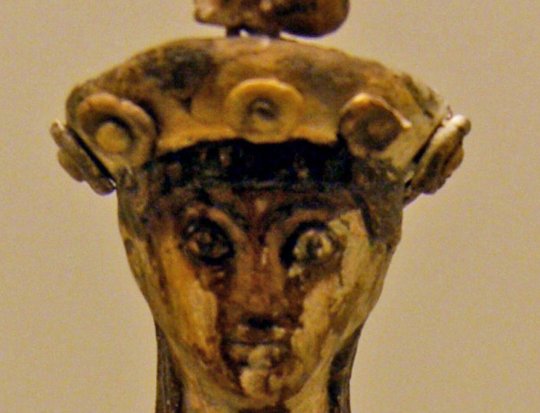
And here’s a close-up of the Boston Goddess’s face:
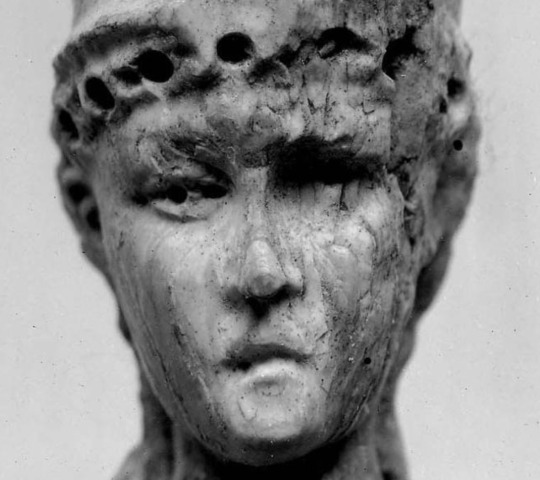
And here’s the face of a now-probably-debunked “Minoan” goddess at the Royal Ontario Museum (read more about her here):
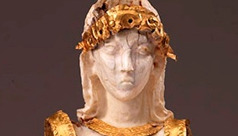
To cut to the chase, eventually they did radiocarbon testing on the Boston Goddess, and the ivory was found to date from between 1420 and 1635 CE. (Not BCE. CE. As in the Renaissance.) A similar figurine, the Seattle Boy God, is made from ivory that's about 500 years old. That in itself is pretty fascinating! They were using old ivory for the forgeries.
What do these proven and suspected fakes have in common? Well, among other things, their very Victorian facial features: inset eyes, small pouty mouths, delicate noses.
Spoiler for where I’m going with this: There are reasons why the Minoans were such an archeological craze, and those reasons are highly political. Because of the ways in which a very specific agenda shaped it, fakes that showed people what they wanted to see were accepted as real (and in some cases, are still sort of accepted as real), and we can't trust a lot of what we supposedly "know."
In Part 2: Bagging On Sir Arthur Evans Forever.
#archaeology#atlantis#minos#crete#minoans#arthur evans#white supremacist archaeology#snake goddess#art forgery#minoan
65 notes
·
View notes
Text
got a new obsession over the weekend...

4 notes
·
View notes
Text
Art forgery is such a ridiculous concept to me. If you have a painting that everyone agrees is a masterpiece, why does it matter if it was painted by a famous painter? Like, here’s two gorgeous paintings that are indistinguishable in terms of style, but one is worth millions and one is trash just because of who painted it.
Isn’t the point of art to look pretty? If you find a gorgeous painting that really speaks to you, isn’t that all it needs to be “real” art?
6 notes
·
View notes
Text
The concept of “fake art” is so funny to me. Because…there’s really no such thing? Like, the art is real. I can touch it. It’s right there. The problem isn’t realness, it’s misattribution.
If I make a perfect copy of the Mona Lisa, that’s a real Mona Lisa! But it’s bad form for me to misattribute the copy to Da Vinci instead of myself. Like, attribution is what’s fake or real, not the art itself.
4 notes
·
View notes
Link
Yes.
8 notes
·
View notes